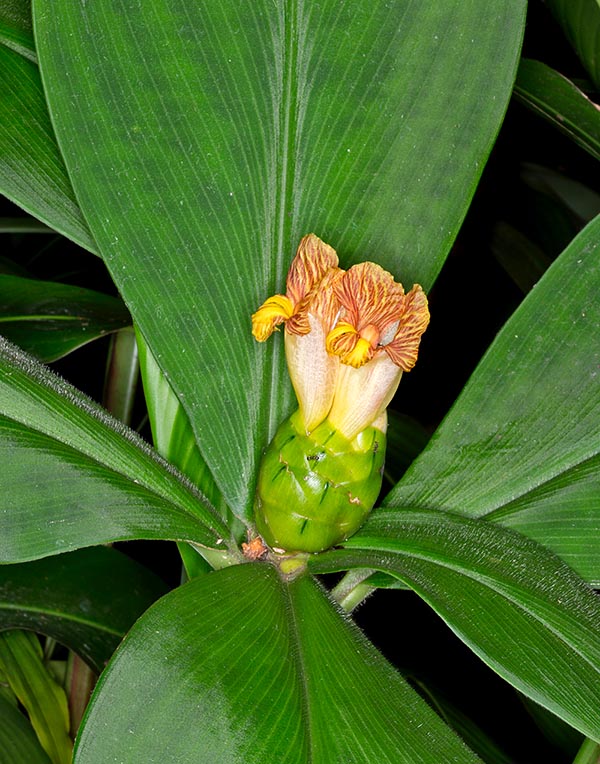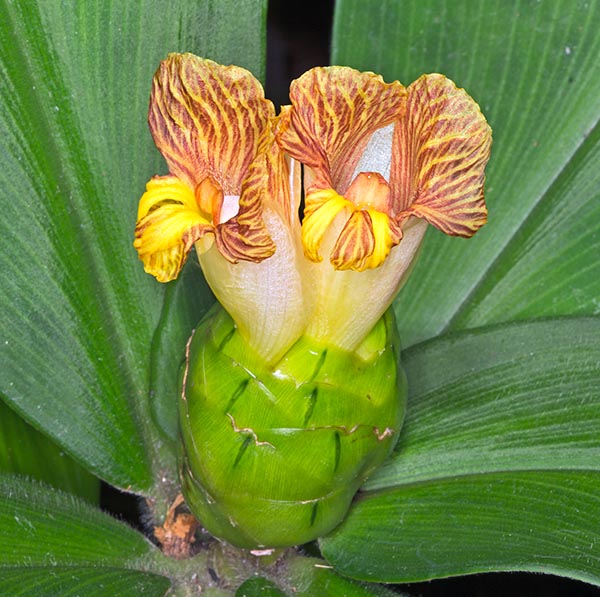Family : Costaceae

Text © Pietro Puccio

English translation by Mario Beltramini

Costus malortieanus is a Central American rhizomatous with villous leaves and stems © Giuseppe Mazza
The name of the genus was given by Linnaeus in honour of Dioscorides who had described a plant, deemed similar, with the name of Kostos; the species is dedicated to the Master of Ceremonies and Minister of the kingdom of Hannover, Carl Ernst von Malortie (1804-1887).
Common names: spiral flag, spiral ginger, step-ladder plant, velvet costus (English); gengibre-espiral, bandeira-espiral (Portuguese-Brazil); caña agria (Spanish).
The Costus malortieanus H.Wendl. (1863) is an evergreen perennial rhizomatous herbaceous species with stems covered by short morbid down, 0,3-1,2 m tall, with green tubular sheath, ciliate at the apex.
The leaves, villous like the stems and spirally arranged, are simple, entire, obovate with pointed apex, 20-30 cm long and 12-22 cm broad, coriaceous, intense green with slightly darker variegations parallel to the secondary nervations on the upper page, glaucous green below.
The terminal inflorescence is a compact globous spike, 3-8 cm long, formed by about 15 ovate imbricate bracts of green colour externally, purple red internally, which enclose hermaphroditic flowers.
The flower presents a small campanulate calyx with three unequal lobes with obtuse apex, 3,5-5 cm long, an oblong-linear fertile stamen curved at the apex, fleshy, white with red apex, and obovate labellum, 4-6 cm long and 4-5 cm broad, formed by the merged fertile stamina, of yellow colour streaked of red, with bent central lobe; the pollinators are hummingbirds and bees belonging to the tribe of the Euglossini Latreille, 1802.
The fruits are white ovoid capsules, about 1,4 cm long and of 1 cm of diameter, containing numerous black seeds with white aril. It reproduces by seed, in loam rich of humus with addition of sand or perlite per a 30%, kept humid and in shaded position, at the temperature of 22-26 °C, and, easily, by division in spring.

The 3,5-5 cm long flowers are pollinated by hummingbirds and bees of the Euglossini tribe © G. Mazza
It is cultivable in the tropical and humid subtropical climate zones, as it does not stand temperatures close to 0 °C except for a very short time, on soils rich of organic substance, draining, kept constantly humid, but without stagnations. It is utilizable, thanks to its reduced size, as edging, in mass, soil cover, but also isolated specimen.
It well adapts to the cultivation in pot for interiors decoration, even if little luminous, with temperatures not less than 15 °C and humidity which can be increased placing the pot on a tray with gravel or other inert kept constantly humid and doing, in presence of air particularly dry, nebulisations with non-calcareous water in order to avoid anaesthetic spots on the leaves. The watering must be regular and abundant in summer, more spaced in winter, but without letting the loam to dry up completely.
Synonyms: Costus elegans Petersen (1890).
→ To appreciate the biodiversity within the family COSTACEAE please click here.
